by Winding Pathways | Jul 8, 2021 | Travel/Columns
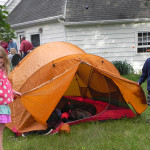
Backyard camping is a good way to start with young children.
Kids love camping. For a youngster a night of camping, even if it’s in the backyard, is an adventure.
This summer the National Wildlife Federation is encouraging people to go camping in national, state, county, or private campgrounds or even in the backyard. They offer a host of information on nwf.
There are lots of ways to camp. We choose to tent but others prefer sleeping in a recreational vehicle or renting a yurt or cabin in the woods for prairie.
Who Camps All Winter?
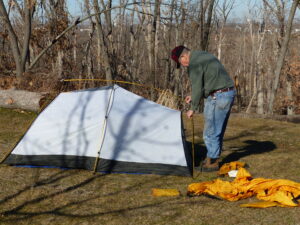
A small tent is cozy
Rich camps out at least once a month all year long, even in winter! When it’s warm the campout is usually in a state park somewhere, but if travel isn’t possible or in winter the little tent gets pitched in the backyard.
Easy Way To Start
Summer backyard camping for kids is easy, fun, and inexpensive. No travel or reservations are needed. An inexpensive big box store tent works OK. We’ve seen them for sale for under $30. They’re not the best in bad weather but they’ll keep bugs and light rain out during a summer yard outing. That’s really all that’s needed. On warm nights kids just need a blanket or sheet, pillow, flashlight, and maybe their favorite stuffed animals or games.
If the weather’s really bad, or winter’s grip is on the land, a kid campout in the living room is also fun. No tent needed. Just drape a big blanket over chairs and make a bed within.
For those who are adventurous like Rich, consider different seasons. Just prepare. Off season camping is great fun.
With so many ways and all seasons to camp, we hope you get outside and play!
-
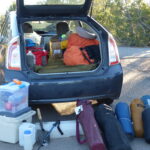
-
Ready to go
-
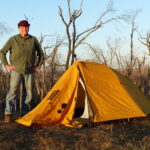
-
Some people like tents.
-
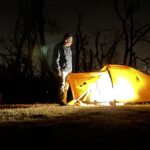
-
A light at night is useful
-

-
For long camping stays a sheepherder tent is just the thing!
-
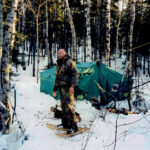
-
These friends really know how to camp year round.
-
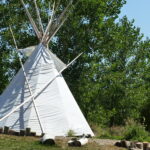
-
We camped outside Yellowstone in a teepee. What fun!
Ready set……go camping!
by Winding Pathways | Jul 1, 2021 | Gazette Features, Hoover's Hatchery, Nature, Travel/Columns
For the past fifteen months Winding Pathways has been busy with writing features for the Cedar Rapids Gazette and blogs for Hoover’s Hatchery and FB Live monthly events. Catch up with our stories in The Cedar Rapids Gazette online.
Hoover’s Hatchery. Click on Flock Journey to read a variety of stories about all things chickens and other poultry. Or News From the Coop blogs.
Here is a list of the more recent features. Just click on the link and read away!
June 13, 2021. Alaska Recreation.
May 22, 2021. Museums of Quad Cities Area. https://www.thegazette.com/recreation/the-many-museums-of-the-quad-cities/
April 18, 2021. Finding Amelia. https://www.thegazette.com/recreation/an-unexpected-search-for-amelia-earhart/
April 11, 2021. Mississippi river Museum and Dubuque
March 25 , 2021 Cedar Falls_Waterloo. Memorable Museums
March 12, 2021. Time Travel. https://www.thegazette.com/subject/sports/outdoors/time-traveling-in-iowa-20210312
March 3, 2021 Entering the Battery Age (column)
February 19, 2021. Franconia Sculpture Park. https://www.thegazette.com/subject/sports/recreation/art-walk-in-a-park-20210219
February 2, 2021. Sprint Cars. https://www.thegazette.com/subject/sports/auto-racing/a-sprint-car-education-20210202
January 14, 2021. Embrace the Outdoors. https://www.thegazette.com/subject/sports/outdoors/embracing-x2014-and-enjoying-x2014-the-cold-outdoors-20210114
*****
December 20, 2020. Walking Cemeteries. https://www.thegazette.com/subject/sports/outdoors/a-peaceful-outdoor-walking-option-20201221
December 14, 2020 Iowa Meat Lockers: https://www.thegazette.com/subject/sports/outdoors/a-meaty-adventure-20201214
Nov 11, 2020 Iowa’s Inland Seas. https://www.thegazette.com/subject/sports/outdoors/enjoying-iowas-inland-seas-20201111
Oct 11, 2020. Barn Quilts. https://www.thegazette.com/article/barn-quilts-offer-brighten-up-the-countryside/
Sept 27, 2020: New Life to dead Trees. https://www.thegazette.com/subject/sports/outdoors/dead-trees-give-life-20200927
September 20, 2020: Walk Outside Safely. https://www.thegazette.com/subject/sports/outdoors/get-outside-and-walk-but-stay-safe-20200920
September 9, 2020: Rebirth Amid the Rubble https://www.thegazette.com/subject/sports/outdoors/a-rebirth-among-the-rubble-of-trees-20200906
August 22, 2020: Iowa’s National Parks. https://www.thegazette.com/subject/sports/outdoors/iowa-national-parks-guide-effigy-hoover-20200822
July 27, 2020: County Parks. https://www.thegazette.com/subject/sports/outdoors/take-advantage-of-iowas-county-gems-20200727
July 11, 2020: Tenting. https://www.thegazette.com/subject/sports/outdoors/why-rv-live-isnt-for-these-senior-tent-campers-20200711
June 26, 2020: Bear Sightings in Iowa: https://www.thegazette.com/subject/sports/outdoors/why-rv-live-isnt-for-these-senior-tent-campers-20200711
April 12, 2020” Walk on Wilder side. https://www.thegazette.com/subject/sports/recreation/take-a-walk-on-the-wilder-side-20200412
by Winding Pathways | Jun 24, 2021 | (Sub)Urban Homesteading, Amphibians/Reptiles, Garden/Yard, Nature
Guest Blog by Leslie Wright
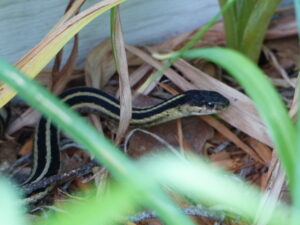
Garter snakes like cool, shady places to wait for a meal.
Just over a year and a half ago, we moved from a home with a suburban postage-stamp-sized yard with little wildlife into a home with a large yard that backs up to a sizable park. Each season we have discovered something new about our new urban “wilderness”. Last spring it was how to identify (and avoid) poison ivy. This spring the theme seems to be reptiles! Earlier this spring I became acquainted with our resident garter snake. Most often it spent time in our vegetable garden but occasionally sunned itself near where I was working in the yard. Though I am not comfortable around snakes I was glad to see him/her – to me a symbol of more abundant life.
How the Adventure Began
Thursday, May 6th seemed like any other lovely spring day. I took myself outside to walk around the gardens and see what was coming up. I walked around to the front of the house to check on hydrangeas I had planted last spring. I had wrapped them in bird netting last year thinking to keep deer from nibbling the tender shoots. To my dismay, I discovered that our resident garter snake had become entangled in the netting, and even worse a much larger snake had also found its way into netting nearby. To my uneducated eyes, this snake looked like a small rattlesnake with a brownish diamond pattern. I was almost relieved that it appeared to be dead. But I knew I needed to rescue my garter snake friend. I was afraid to do this myself – afraid of getting bitten mostly.
So, I started to call and text everyone I could think of to rescue this snake – and me! My husband who was in a meeting, the nature center, DNR. But, alas, I soon figured out I was going to have to tackle this myself if I wanted the snake to survive. So off to Google I went.
Google To The Rescue!
The snakes had netting in their mouths and wrapped around their bodies, multiple times. Google informed me I would need to gently restrain the snake and use nail scissors to cut it free. So, I put on gardening gloves, found a stick with a small fork to hold the snake’s head, and armed myself with nail scissors. Probably more to calm myself, I talked to my little friend while I cut away the netting. Success! After I freed the garter snake I went inside for a moment.
-
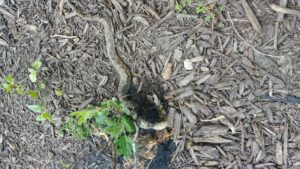
-
Netting gets caught in the snake’s scales when it tries to back out of the netting.
-
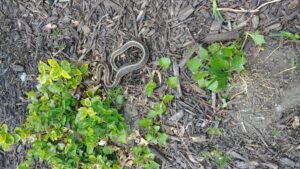
-
This snake slithered off when freed.
Rounds Two and Three
When I came back out – no lie – he/she had found its way into another piece of netting. So, round two – gloves, stick, and scissors. It was clear I needed to remove every shred of that darn bird netting to make sure it would not harm any other creatures. As I was clearing away the netting, I discovered the second snake was in fact alive. Now I had to save it, too! So round three – gloves, stick, and scissors, and the second snake was free. I later learned this is a fox snake.
All Is Well That Ends Well
I haven’t seen them since but I surely hope they are safe, well, and still visiting our yard.
by Winding Pathways | Jun 17, 2021 | (Sub)Urban Homesteading, Pests
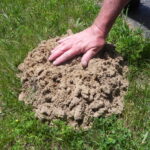
Moles sometimes push up excess dirt.
It’s that season again. Recently we spotted a symmetric dirt cone poking up in our lawn. Fortunately, it wasn’t an early-stage volcano about to erupt. Rather, a mole pushed dirt out of the way so it could continue tunneling.
People hate moles for forming similar dirt piles and their humped tunnels that lawnmower blades sometimes catch. Here’s some basic mole information to help change perspective from a “problem” to a resource and “radical welcoming”.
A Mole Primer
Moles are small mammals of several species that live across North America, Asia, and Europe. They make their living tunneling through the earth to find earthworms and other invertebrates to eat. Contrary to popular belief moles don’t eat plants or roots. They make two types of tunnels. One is fairly deep and is a mole’s highway. It’s for transportation. The other is the familiar humped tunnel moles create to find food that usually is just below the soil surface. Every once in a while, a tunneling mole needs to get rid of some dirt, so they push it to the surface, creating a molehill.
Mole or Gopher?
People confuse moles with gophers. Both are small tunneling animals, but they are very different in these ways:
- Moles eat invertebrates, not plants. Gophers eat plants and roots.
- Moles are most common in moist shady soil and suburban yards. Gophers are more common in open sunny areas, like pastures, and rarely enter suburbia.
- Moles create symmetric hills of dirt. Gophers make elliptical-shaped mounds.
- Mole populations are usually small, while there may be many gophers living in an area.
By softening and aerating the soil both types of animals promote long-term soil health. Often an area bordering a mole tunnel will have the greenest grass in the lawn, for example.
Killing Moles
Mole dislike is so intense that many people work hard to kill any that dare tunnel in their yard. Here are two common mole weapons and why we don’t use them:
- Plunge-type traps impale a hapless mole. We worry that a neighborhood child or someone’s pet could be speared by one of these traps, which also are cruel.
- Poison peanuts are sold in garden stores. The package may say the peanuts will kill moles……and they will if you can get a mole to eat one, but remember that moles eat worms and insects, not peanuts or plants. A peanut is a plant. So people who buy poisoned peanuts are wasting their money and poisoning critters that may eat the poisoned peanut. Like a favorite, curious dog.
What We Do with Moles at Winding Pathways
We view our moles as another interesting and beneficial animal that shares our yard. Yup, mole tunnels kill a strip of grass in the short term, but in the long term, mole activity improves the soil. Worms and most other invertebrates contribute to soil health, so we know if we have moles, we have a healthy lawn.
What to Do About Moles
There are two ways to deal with moles. First, a homeowner can set traps and poison and attempt to kill beneficial animals. Second, forget trying to “get rid” of moles. Instead, just tamp down their tunnels before mowing, and don’t worry about them.
We follow the second.
by Winding Pathways | Jun 10, 2021 | (Sub)Urban Homesteading, Foraging
For years we’ve added wild foraged plants to our diet. They’re free, available, often delicious, and give us the satisfaction of knowing that we can find food close to home.
After years of foraging and trying many wild foods, we now place them into three categories:
- Common, easily gathered and prepared, and tasty.
- Tasty plants but tedious to gather and prepare. Often we just don’t have the patience and time to gather and cook them.
- Ones that are difficult and time-consuming to gather and prepare, and are not especially tasty. These would be worthy food in an emergency but not normally worth the time and effort to gather and prepare.
We concentrate on the first category and one of our favorites is lambsquarters. It’s common just about everywhere. We’ve spotted it beside urban sidewalks, on the edge of farm fields, and in nearly every garden. The plant springs up like magic between rows of vegetables, and too often the gardener rips or hoes them out as weeds. It used to have more respect here. People in some countries still honor and harvest lambsqurter.
Easy Peasy Lambsquarter
Lambsquarters are as delicious as any vegetable we plant in our garden. We don’t need to buy seeds and plant them. They just appear like magic and grow fast as soon as the weather warms. We begin eating them about bean and pumpkin planting time.
Lambsquarters are sometimes called pigweed, goosefoot, wild spinach, or wild beet. They are an amaranth and often grow in large clumps. An easy way to identify them is to examine the top of young plants and the bottom side of leaves. They look white, and drops of water readily slide off.
Like most garden and wild greens, lambsquarters are best harvested when the leaves are new and small. Big summer leaves become tough and bitter. To speed up gathering we sometimes use a big pair of garden scissors to snip them off. Then we thoroughly rinse them to wash off any grit.
Young lambsquarter leaves can be added to salads, but we usually steam them for a few minutes. They’re delicious with a touch of melted butter.
-
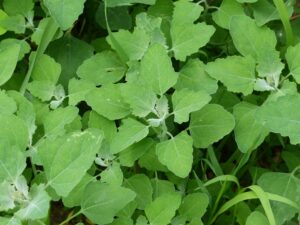
-
A prolific edible.
-
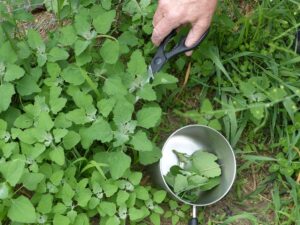
-
We use scissors to snip the tender lambsquarter leaves.
Beware: Before we eat any wild plant new to us we do the following:
- Positively Identify the plant from at least two sources. For example, we confirm identification from any combination of wild food books, credible Internet sites, or knowledge gained first hand from a wild food expert.
- Avoid collecting plants that may be contaminated by farm or lawn chemicals, car fumes, or animal feces or urine.
- Thoroughly wash the plants two or three times.
- Follow cooking or eating instructions found in foraging books or credible Internet sites.
- Eat sparingly the first time. A plant may be perfectly edible for most people but others could be allergic to it. Assuming there’s no digestive problem or adverse reaction after eating a small taste we then enjoy larger servings.
Lambsquarters are delicious, prolific, and are ready to pick all summer. We add them to our meals often. This addition of a nutritious food helps us be less dependent upon the grocery store for our dinner.














